The Department of Antiquities of the Deputy Ministry of Culture of the Republic of Cyprus announces the completion of the 2025 excavation at the site of Kofinou–Agios Herakleios and Menogeia–Limnes. The excavations were conducted by the field project of the Archaeological Research Unit and the Archaeological Summer Field School of the Department of History and Archaeology at the University of Cyprus, titled “Settled and Sacred Landscapes of Cyprus” (SeSaLaC), from 1 July to 31 July 2025. The project was directed by Dr Athanasios Vionis, Associate Professor at University of Cyprus, and Dr Doria Nicolaou.
The excavation at the site of Kofinou–Agios Herakleios focused on two areas: south and east of the ruined chapel of Agios Herakleios, also known as the “martyrion”. It was confirmed that the remains of a single-aisled barrel-vaulted church excavated in 2025 belong to a later (medieval) phase, built on top of an earlier three-aisled basilica, probably dated to the early 7th century AD. The second single-aisled church was supported by three arches with buttresses, while remains of frescoes and stone fragments were also identified (among the collapse layer), testifying to the decoration and function of its interior.
Another important find was the discovery of a burial inside a stone larnax (from early Byzantine times) on the outer side of the south wall of the “martyrion”, in which a human skeleton was found in situ. In addition, new trenches south of the “martyrion” revealed two parallel walls that probably defined part of the narthex of the original (early Byzantine) basilica. The existence of a hearth and a mortar base to the west and south within the same trenches are associated with later uses of this space in the Late Middle Ages.
The ceramic finds from the collapse layer of the single-aisled church (east of the “martyrion” of Agios Herakleios) date from the late 14th to the mid-16th century, while the site, as was evident from the first excavation season in 2024, was used continuously from the 6th to the 16th century, with successive phases of ritual and burial use. Our excavation documents for the first time in Cyprus the existence of an organised cemetery around a basilica in the rural countryside, possibly founded in the 6th-7th century AD.
At Menogeia–Limnes, the excavation focused on a trial trench at a site identified as a pottery workshop dated to the 5th-7th centuries AD, with a significant concentration of wasters, unfired clay, and combustion residues. A structure with a circular notch built into the natural rock was uncovered, probably near a kiln. The finds include numerous pottery wasters, charcoal, glass, and metal fragments, confirming the site’s function as a rural industrial centre during the Early Byzantine period.
Excavations at both sites shed light on important aspects of daily life in rural Cyprus from the Early Byzantine period to the Late Middle Ages, revealing the continuous use of those areas in the Xeros valley for residential, ritual, and production purposes. This data also bridges the archaeological gap of the so-called “Dark Ages” of Byzantine Cyprus and contribute to our better understanding of the economic and social organisation of the region.








